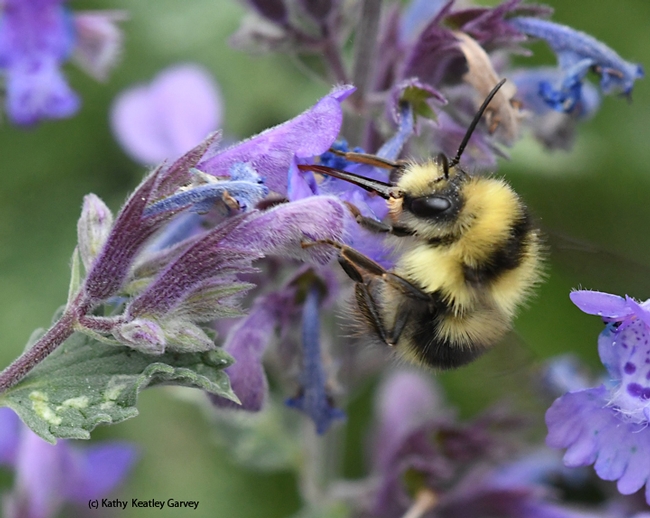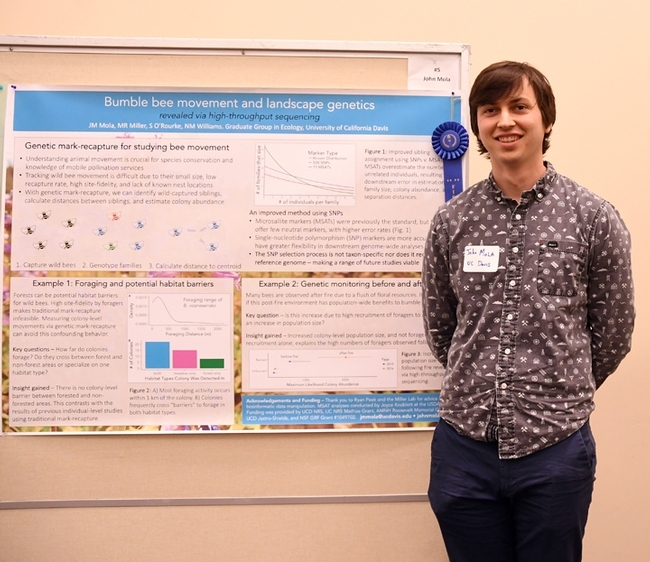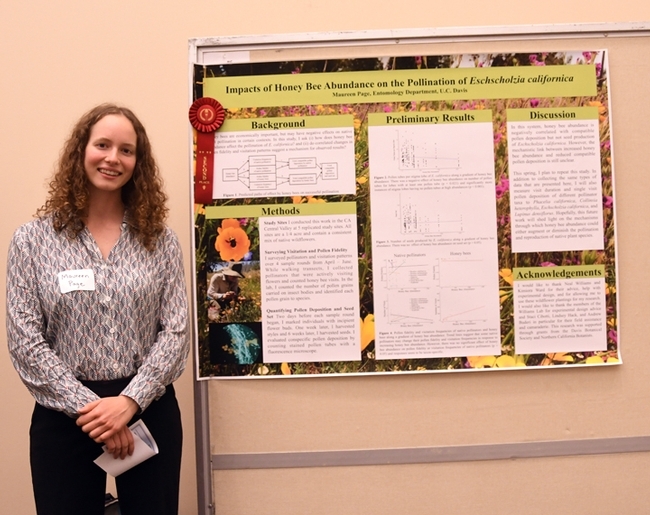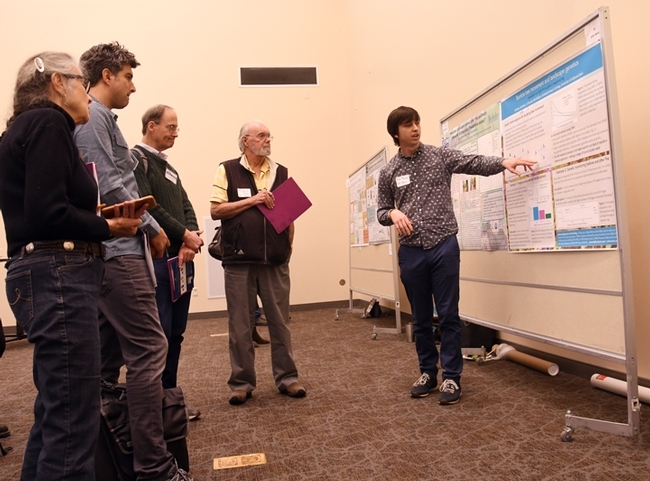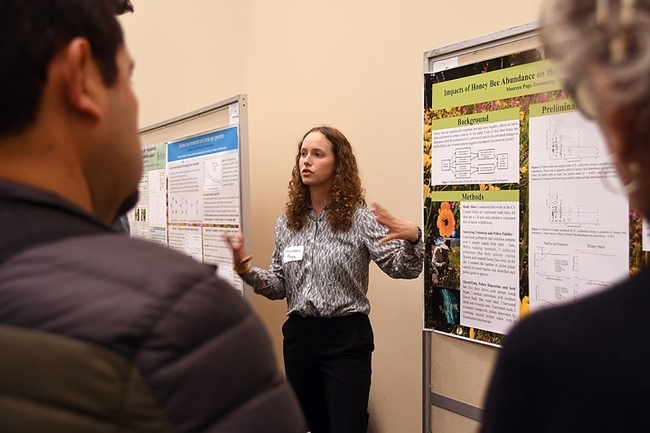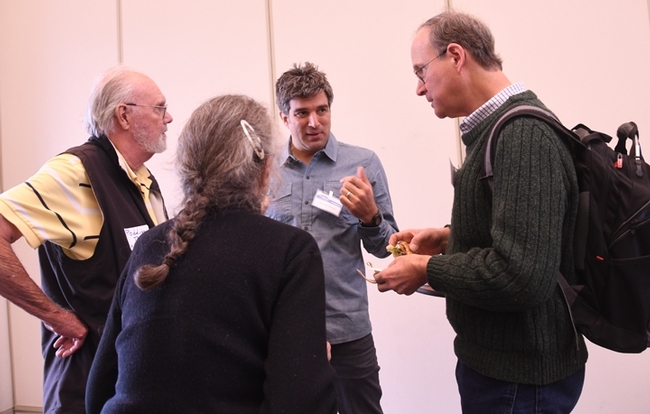- Author: Kathy Keatley Garvey
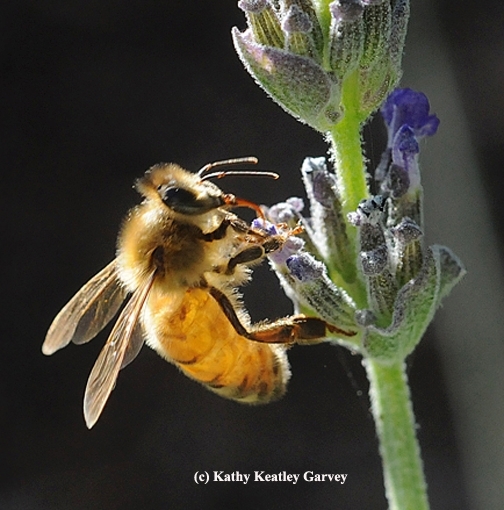
The scene: A honeybee (Apis mellifera) and a bumblebee (Bombus vosnesenskii) nectaring on a purple coneflower (Echinacea purpurea) in a UC Davis bee garden.
If you've observed honeybees and wild bees foraging in your garden, you've probably wanted to compare them. Is the honey bee the most effective pollinator?
Newly published UC Davis research in the American Journal of Botany yields some surprising results.
Honeybees are effective pollinators, but when compared to other pollinators, including wild bees, they are rarely the most effective plant pollinators, according to a meta-analysis project led by doctoral candidate Maureen Page and postdoctoral researcher Charlie Casey Nicholson of the Neal Williams laboratory, UC Davis Department of Entomology and Nematology.
Page and Nicholson are the co-leading authors of "A Meta-Analysis of Single Visit Pollination Effectiveness Comparing Honeybees and other Floral Visitors," the cover story of the current edition of the journal, published Nov. 30.
“Although high visitation frequencies make honeybees important pollinators, they were rarely the most effective pollinators of plants and were less effective than the average bee,” said Page. “This suggests that honeybees may be imperfect substitutes for the loss of wild pollinators and ensuring pollination will benefit from conservation of non-honeybee taxa. In the future, we hope other researchers will use the data we have collected to further investigate the factors that influence pollination effectiveness.
Page and Nicholson originated the idea for the project during a graduate seminar led by UC Davis professor and community ecologist Louie Yang in the winter of 2020. While the COVID-19 pandemic shut down or postponed many other research projects, Page and Nicholson forged ahead and organized fellow graduate students and postdoctoral students to collectively read and extract single visit-effectiveness data from more than 468 papers. The two then analyzed the data from a subset of these papers (168) to ask whether honeybees and other floral visitors differed in their single visit pollination effectiveness.
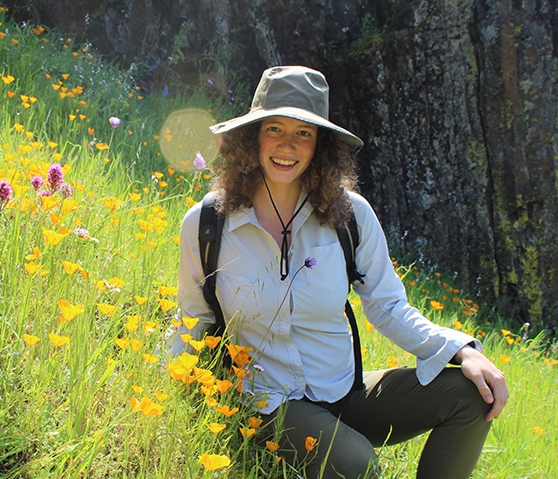
The researchers conducted a hierarchical meta-analysis of 168 studies and extracted 1564 single visit effectiveness (SVE) measures for 240 plant species. “We paired SVE data with visitation frequency data for 69 of these studies,” they wrote. “We used these data to ask three questions: (1) Do honeybees (Apis mellifera) and other floral visitors differ in their SVE? (2) To what extent do plant and pollinator attributes predict differences in SVE between honeybees and other visitors? (3) Is there a correlation between visitation frequency and SVE?”
They compared honeybees to multiple pollinator groups, including ants, bees, beetles, birds, butterflies, flies, moths, and wasps.
"Surprisingly, honeybees were less effective than other bees as pollinators of crop plants, suggesting that the importance of honeybees as crop pollinators derives largely from their numerical abundance rather than the quality of their floral visits," Page said.
“Honeybees were significantly less effective than the most effective non-honeybee pollinators but were as effective as the average pollinator," they wrote in their results section of the paper. "The type of pollinator moderated these effects. Honeybees were less effective compared to the most effective and average bird and bee pollinators but were as effective as other taxa. Visitation frequency and SVE were positively correlated, but this trend was largely driven by data from communities where honeybees were absent.”
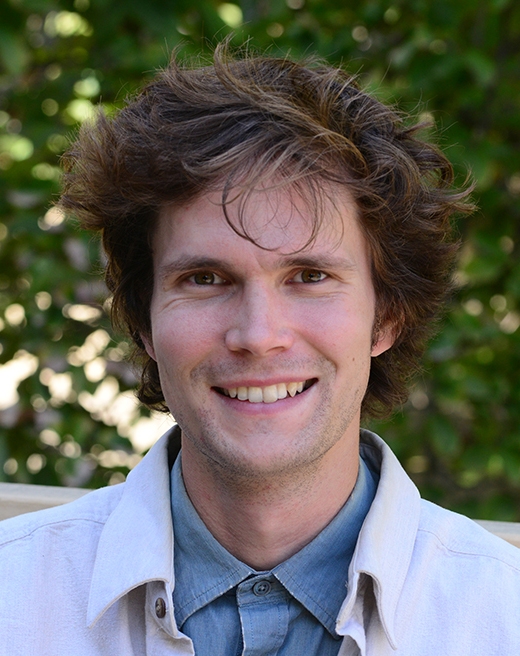
Also contributing to the project were Ross Brennan, Anna Britzman, Jessica Greer, Jeremy Hemberger, Hanna Kahl, Uta Müller, Youhong Peng, Nick Rosenberger, Clara Stuligross, Li Wang, and Professors Louie Yang and Neal Williams.
Cover Photo. The cover photo, by Kathy Keatley Garvey, communications specialist, UC Davis Department of Entomology and Nematology, shows several species of bees on a sunflower, Helianthus sp. They include a honeybee (Apis mellifera), sunflower bee (Svastra obliqua), and two sweat bees (Halictus tripartitus and Halictus ligatus), as identified by Professor Williams, a pollinator ecologist.
"Honeybees are as effective as the average pollinator, but rarely the most effective pollinators of plants," according to the caption. "Surprisingly, honeybees are less effective than other bees as pollinators of cultivated plants, suggesting the importance of honeybees as agricultural pollinators derives largely from their numerical abundance. Their study confirms a widely held belief that honeybees are not the best pollinators of plants globally and substantiates the growing concern that honeybees may be imperfect substitutes for the loss of wild pollinators."
Charlie Nicholson. Nicholson, a researcher in the UC Davis Department of Entomology and Nematology labs of both Professor Neal Williams, and Extension apiculturist Elina Lastro Niño, holds a bachelor of arts degree in biology (evolution, ecology and behavior), 2010, cum laude, from Skidmore College, Saratoga Springs, New York. He received his doctorate in natural resources in 2018 from the University of Vermont, where he was a Gund Institute for Environment graduate fellow. In his dissertation, he examined how landscape and farm management affect the multiple benefits provided by wild bees.
Nicholson joined UC Davis as a postdoctoral scholar in the spring of 2019, and receives funding support from the USDA Invasive Species and Pollinator Health Unit. He recently co-authored a paper, “Natural Hazard Threats to Pollinators and Pollination,” published in the journal Global Change Biology, that analyzed 117 published research papers on natural hazards that threaten pollinators and pollination.
Maureen Page. Page received her bachelor's degree in biology, cum laude, from Scripps College, Claremont, Calif., in 2016, and then enrolled in the UC Davis entomology graduate program, with a career goal of becoming a professor and principal investigator. In 2018, she received prestigious three-year fellowship, a National Defense Science and Engineering Graduate Fellowship, for her research proposal, “Promoting Food Security by Optimizing Wildflower Plantings to Support Wild and Managed Bees." Long interested in bee research, Page received a 2013 Scripps Environmental Research Grant to establish a solitary bee monitoring program at the Bernard Field Station in Claremont. She created a reference collection and species list of bee diversity at the field station, gaining experience collecting, pinning and identifying bee specimens. She presented her findings at the Scripps Undergraduate Research Symposium. Page later worked on a project categorizing pollen deposition by the yellow-faced bumble bee, Bombus vosnesenkii to California figwort, Scrophularia california.
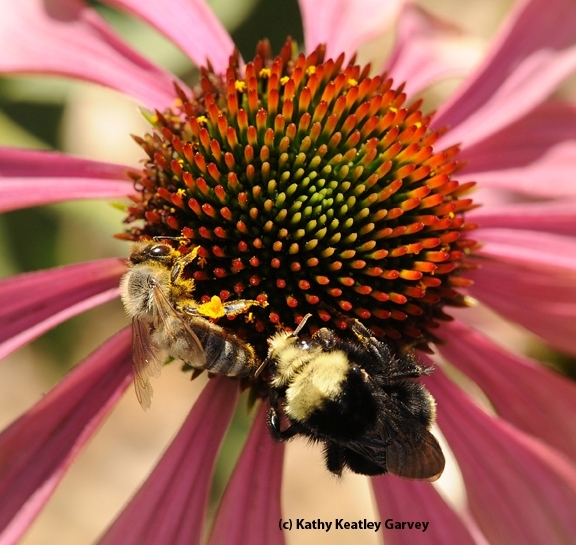
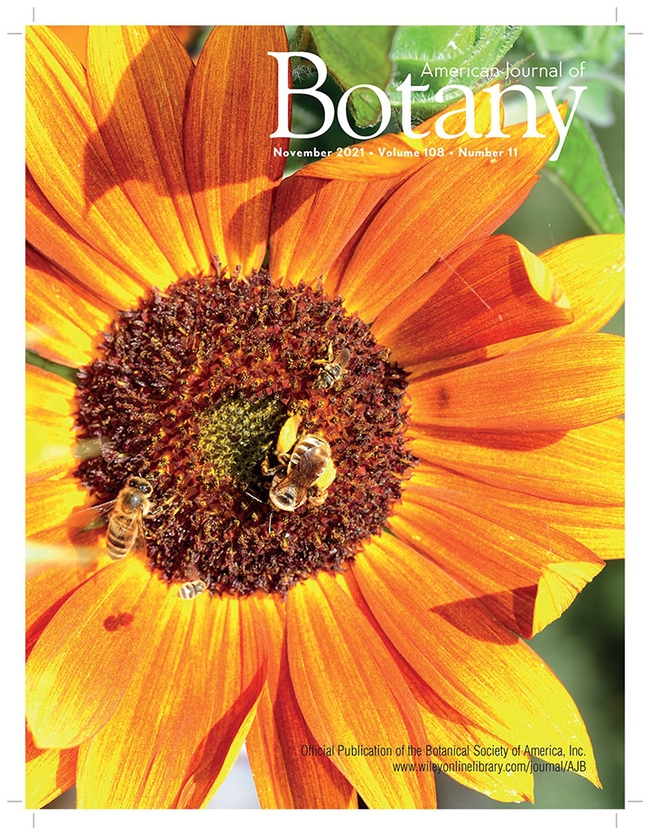
- Author: Kathy Keatley Garvey
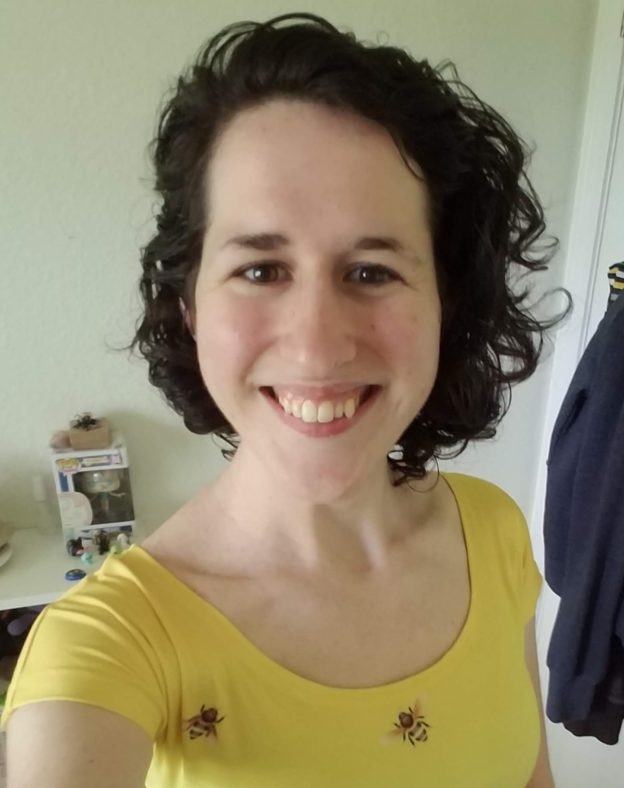
That's the beginning of the abstract of her research presentation, "Fungicide Impacts on Bumble Bees Are Mediated via Effects on Bee-Associated Fungi," that she delivered Nov. 1 in the mile-high city of Denver at the Entomological Society of America's annual meeting.
Rutkowski, a member of the lab of community ecologist Rachel Vannette, associate professor, UC Davis Department of Entomology and Nematology, and co-advised by community ecologist and professor Rick Karban, was participating in the 10-minute graduate student speech competition.
How did she do? She excelled! Rutkowski won first place, "The President's Prize," in her category, Plant-Insect Ecosytems, Ecology 3.
That's quite an achievement and well-deserved.
The remainder of her abstract: "Using two species, Bombus vosnesenskii and B. impatiens, we test the interactive effect of the fungicide propiconazole and fungal supplementation on the survival, reproduction, and microbiome composition of microcolonies (queenless colonies). We found that both bee species benefitted from fungi, but were differentially affected by fungicides. In B. vosnesenskii, fungicide exposure decreased survival while fungal supplementation mitigated fungicide effects. For B. impatiens, fungicide application had no effect, but fungal supplementation improved survival and offspring production. Fungicides altered fungal microbiome composition in both species, and reduced fungal abundance in B. vosnesenskii microcolonies, but not in B. impatiens, where instead fungal addition actually decreased fungal abundance. Our results highlight species-specific differences in both response to fungicides and the nature of fungal associations with bees, and caution the use of results obtained using one species to predict the responses of other species. These results suggest that fungicides can alter bee- fungi interactions with consequences for bee survival and reproduction, and suggest that exploring the mechanisms of such interactions, including interactions within bee-associated fungal communities, may offer insights into bumble bee biology and bumble bee conservation strategies." (Paper co-authored with Rachel Vannette, Eliza Litsey and Isabelle Maalouf)
Two other outstanding UC Davis doctoral students scored second place in their respective categories in the highly competitive events:
- Maureen Page, with the lab of pollinator ecologist Neal Williams, professor, UC Davis Department of Entomology and Nematology, presented "Optimizing Pollinator-friendly Plant Mixes to Simultaneously Support Wild and Managed Bees." She competed in the category, Plant-Insect Ecosystems: Pollinators. (Hannah McKenzie of Ohio State University won first place, The President's Prize.)
- Kyle Lewald, with the College of Biological Sciences and the Integrated Genomics and Genetics Graduate Group, but a member of the lab of molecular geneticist and physiologist Joanna Chiu, professor and vice chair of the UC Davis Department of Entomology and Nematology, competed in the category, Systems, Evolution and Biodiversity: Genetics and Molecular Biology. He titled his presentation: "Assembly of Highly Continguous Diploid Genome for the Agricultural Pest, Tuta absoluta." (Amanda Markee of the University of Florida took home first place, The President's Prize.)
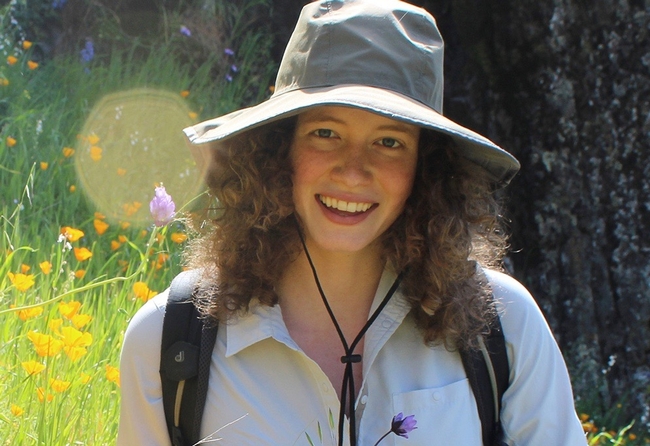
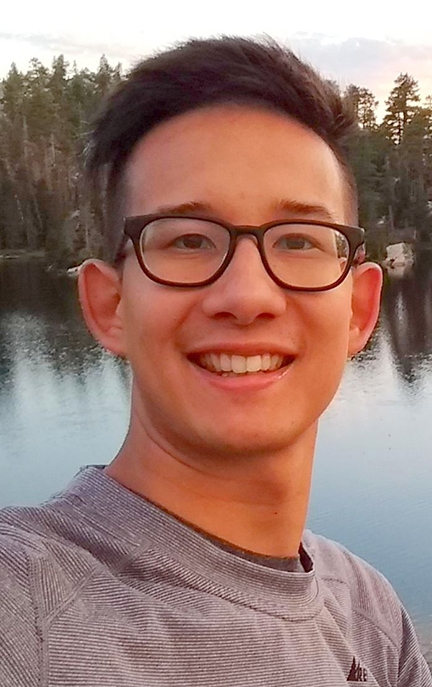
At the ESA's annual meetings, students are offered the opportunity to present their research and win prizes. There are several components, ESA says, to the competition: 10-minute papers (oral), posters, and infographics. First-place winners receive a one-year free membership in ESA, a $75 cash prize, and a certificate. Second-winners score a one-year free membership in ESA and a certificate.
The 7000-member organization, founded in 1889 and headquartered in Annapolis, Md.,, is the world's largest organization serving the professional and scientific needs of entomologists and others in related disciplines. Its members are in educational institutions, health agencies, private industry, and government. The 2021 ESA president is Michelle Smith of Corteva Agriscience.
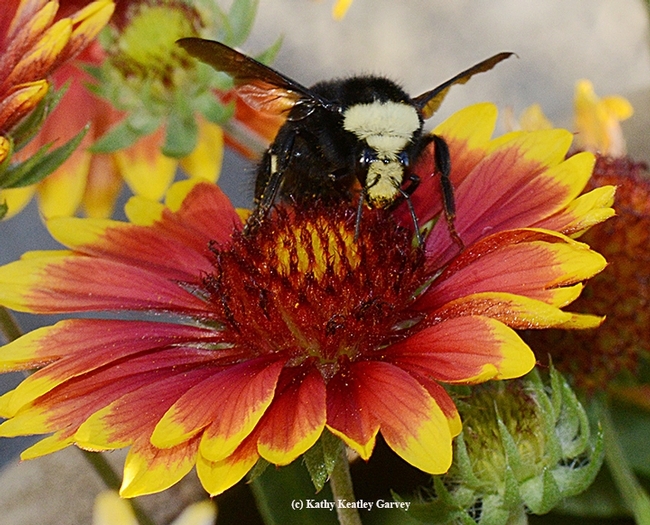
- Author: Kathy Keatley Garvey
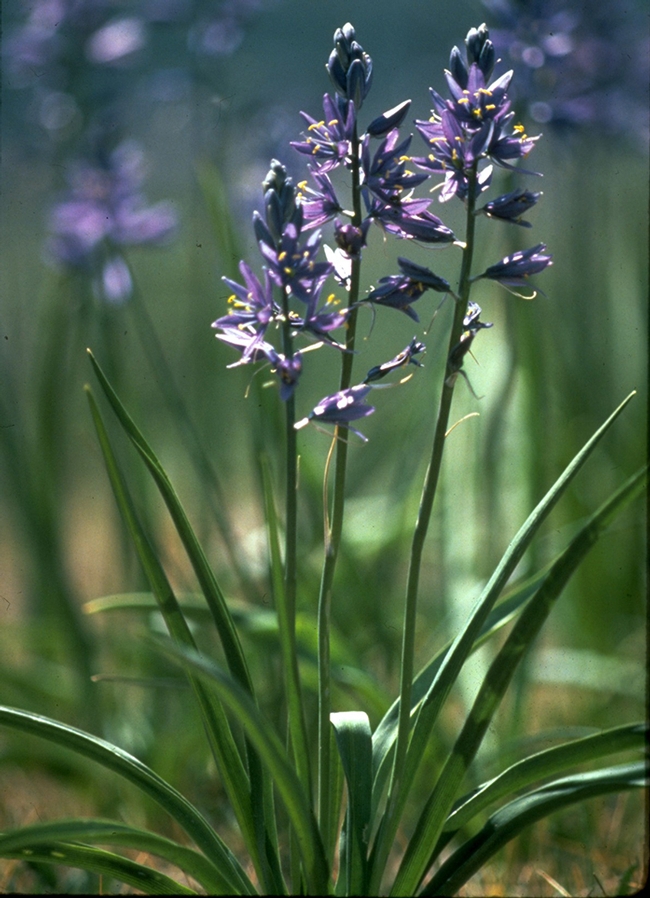
That's the topic that doctoral candidate and pollination ecologist Maureen Page of the Neal Williams lab, UC Davis Department of Entomology and Nematology, will explore when she addresses the Davis Botanical Society meeting, “How I Spent My Field Season” on Thursday Nov. 14.
The event takes place from 5 to 6 p.m. in Room 1022 of the Life Sciences Addition, corner of Hutchison and Kleiber Hall drives. Page, of the Entomology Graduate Group, and fellow speaker Emily Brodie of the Ecology Graduate Group, are recipients of Davis Botanical Society grants. Brodie, seeking her master's degree, will speak on “Patterns of Post-Fire Diversity and Regeneration in Subalpine Forests of California."
The wildflower that Page studies is a perennial herb, native to Western America. It's commonly called camas, small camas, or quamash.
In her abstract, Page writes: "While many bee species are declining, managed species, such as honey bees, have been introduced into novel ecosystems across the globe. Many studies support the claim that introduced honey bees compete with native bees. However, less is known about how honey bee introductions will affect native plant populations. Increased pressure from beekeepers to place hives in National Parks and Forests combined with the potentially huge but poorly understood impacts that non-native honey bees have on native plant populations makes exploring impacts of honey bee introductions on native plant pollination of pressing concern.”
The impact of honey bee introductions on the pollination and reproduction of the Sierra wildflower? “A preliminary data analysis suggests that honey bee introductions lead to increased visitation by honey bees and decreased visitation by native bees," Page says. "Preliminary results also suggest that honey bees are ineffective pollinators of Camassia quamash and the replacement of native bee visits by honey bee visits leads to reduced seed set. This research demonstrates that species introductions can have negative effects on plant pollination when they lead to an over-representation of visits by ineffective pollinators."
Page focuses her research on pollination ecology and bee conservation in natural and agricultural landscapes. As part of her dissertation research, she studies the impacts of honey bee introductions on plant-pollinator interactions and the pollination of native plants. She is also working to optimize wildflower plantings to simultaneously enhance honey bee nutrition and maximize support of diverse bee communities while minimizing competition between native and managed pollinators.
Last year Page received a prestigious three-year fellowship, a National Defense Science and Engineering Graduate Fellowship, for her research proposal, “Promoting Food Security by Optimizing Wildflower Plantings to Support Wild and Managed Bees.” This highly competitive fellowship, funded by the Department of Defense, drew more than 3600 applicants. Maureen was one of 69 awardees.
The Nov. 14th event is free and open to the public. For more information, contact Teri Barry or Jennifer Poore at the UC Davis Center for Plant Diversity (530) 752-1091 or tcbarry@ucdavis.edu or jpoore@ucdavis.edu.
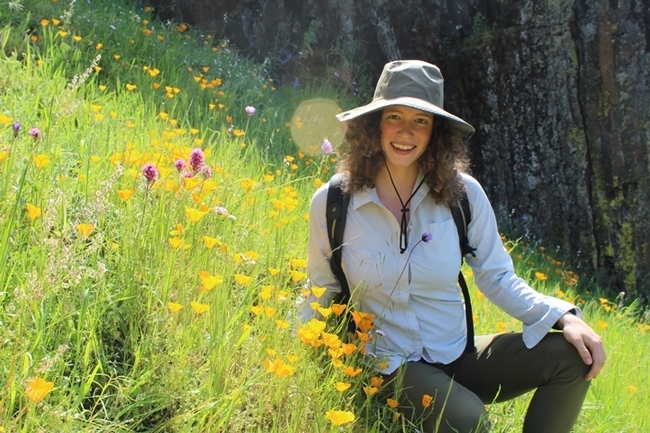
- Author: Kathy Keatley Garvey
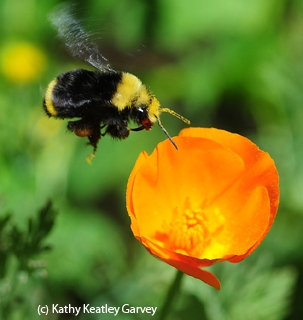
She's the recipient of a prestigious three-year fellowship, a National Defense Science and Engineering Graduate Fellowship, for her research proposal, “Promoting Food Security by Optimizing Wildflower Plantings to Support Wild and Managed Bees.”
This highly competitive fellowship, funded by the Department of Defense, drew more than 3600 applicants. Maureen was one of 69 awardees.
“The fellowship is well deserved,” said Williams, her major professor and a pollination ecologist and a UC Davis Chancellor's Fellow. “Maureen is a talented researcher, who shows a real passion for her research that is combined with a highly analytical meticulous approach.”
Of her project, Williams said: “Her work melds careful field sampling with advanced analysis, including computational optimization modeling. It will move existing research to a new level by exploring the nutritional basis of competitive interactions among pollinators. The project builds from a solid foundation but his highly innovative. Its results should be of tremendous value to the scientific community, but are also highly relevant for decision making to promote sustainable food systems for California and beyond.”
Page received her bachelor's degree in biology, cum laude, from Scripps College, Claremont, Calif., in 2016, and then enrolled in the UC Davis entomology graduate program, with a career goal of becoming a professor and principal investigator.
“I became interested in UC Davis because I was interested in working in Neal's lab,” she related. “After my sophomore year of college, I participated in National Science Foundation's Research Experiences for Undergraduates (NSF REU) with the Chicago Botanic Gardens. One of the professors I was working with, Jennifer Ison, told me that my research interests aligned well with the work coming out of Neal's lab and I quickly realized she was right.”
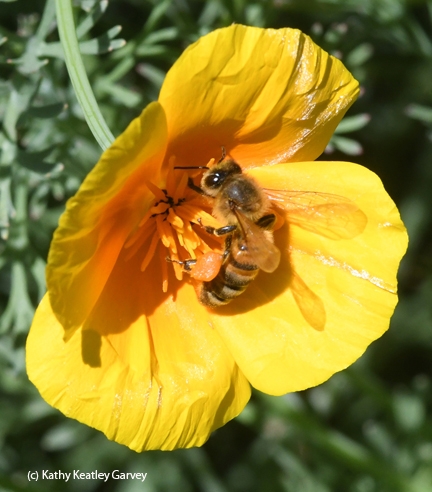
Her dissertation research focuses on using plant-pollinator interaction networks to (1) assess the impact of honey bee introductions on native plant pollination and (2) optimize wildflower plantings to simultaneously support honey bee health and diverse native bee communities.
“I've always loved flowers and I think my love of bees grew out of my academic interest in pollination ecology and a desire to apply my talents towards research that would benefit farmers and pollinator conservation efforts,” said Page, a native of San Francisco but who grew up in Ashland, Ore.
As a volunteer researcher for Southern Oregon University, she worked on a watershed project in the Klamath-Siskiyou Wildlands Center, and was named the City of Ashland's Conservationist of the Year in April 2012. The city honored her at its Earth Day celebration.
Keenly interested in bee research, Page received a 2013 Scripps Environmental Research Grant to establish a solitary bee monitoring program at the Bernard Field Station in Claremont. She created a reference collection and species list of bee diversity at the field station, gaining experience collecting, pinning and identifying bee specimens. She presented her findings at the Scripps Undergraduate Research Symposium. Page later worked on a project categorizing pollen deposition by the yellow-faced bumble bee, Bombus vosnesenkii to California figwort, Scrophularia california.
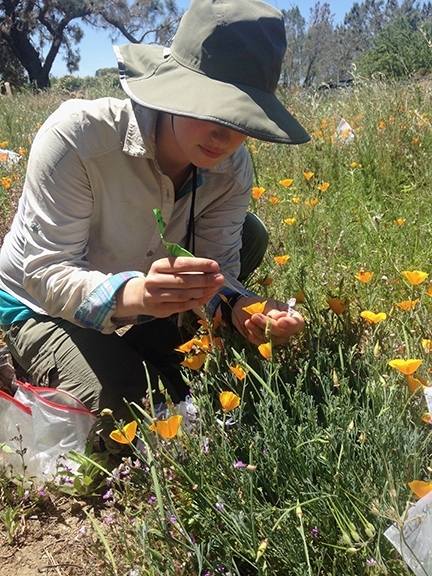
An average day?
“My field season has started, so on an ‘average day' I'm at one of my lab's wildflower plantings by 7 a.m. and driving home with coolers of bees and flowers around 7 p.m.,” Page said. “The most fun part of my fieldwork is using something called a ‘mobile bouquet' to measure single-visit pollen deposition by different pollinator taxa to different plant taxa.”
Page was awarded a grant from the Davis Botanical Society earlier this year, and won second place in the graduate students' poster competition at the 2018 UC Davis Bee Symposium for her poster, “Impacts of Honey Abundance on the Pollination of Eschscholzia californica. Last year she received a Northern California Botanists' Grant and a Davis Botanical Society Grant.
Eager to reach youth about the importance of pollinators, Page began volunteering in 2016 for the Center for Land-Based Learning, mentoring students from Sacramento High School, and engaging them in hands-on conservation science at Say Hay Farms, a 20-acre family farm in Yolo County. She has taught students at her Davis area field site about the benefits of providing wildflower habitat for pollinators.
The UC Davis doctoral student has also presented lectures at the Hoes' Down Harvest Festival, Yolo County, on “Pollinators on the Farm” and led a kids' bug hunt. She presented an invited lecture on “Beneficial Insects in Home Gardens” to the El Dorado Master Gardeners, part of the UC Cooperative Extension program, and volunteered at their other activities.
Page serves as secretary of the UC Davis Entomology Graduate Student Association. In her leisure time, she enjoys “baking, rock climbing, learning new things, and sketching--mostly-flowers, bees, and sometimes butterflies.”

- Author: Kathy Keatley Garvey
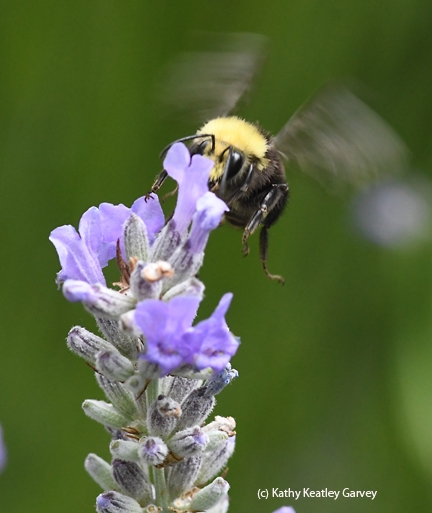
John Mola, a fourth-year doctoral student in the Neal Williams lab, UC Davis Department of Entomology and Nematology, won the $850 first-place award with his presentation on "Bumble Bee Movement and Landscape Genetics."
“In conservation biology and ecological study, we must know the distances organisms travel and the scales over which they go about their lives,” Mola said of his work. “To properly conserve species, we have to know how much land they need, how close those habitats need to be to each other, and the impact of travel on species success. For instance, if I'm told there's free burritos in the break room, I'm all over it. If the 'free' burritos require me traveling to Scotland, it's not worth it and I would spend more energy (and money) than I would gain. For pollinators, it's especially important we understand their movement since the distances they travel also dictates the quality of the pollination service they provide to crop and wild plants."
“Despite this importance, we know comparatively little about the movements of bees--the most efficient of pollinators--due to the difficulty of tracking individuals," Mola explained. "Unlike birds or large mammals, we can't just attach large radio collars and follow them around. As such, my work has focused on improving methods that we can use for study. I use a combination of landscape ecology and molecular genetics to identify the locations of siblings (colony-mates) in landscapes. From that information, we can infer all sorts of useful information about the potential foraging range, habitat use, population size, etc. It's a very exciting time to be working on these topics as the availability of new genetic and GPS technologies allows us to answer or re-address scientific and conservation issues with bees.”
In his abstract, Mola related: "Understanding the way organisms move through environments is crucial to our ability to monitor, study, or conserve species--after all, a habitat that is wholly inaccessible is no habitat at all. However, studies of wild bee movement lag far behind those of many numerous individuals. This limits our ability to answer basic questions like how large of an area is needed for individuals to forage? Or how close do conservation areas need to be connected? For honey bees, we can answer these questions through the study of their infamous waggle dance--which reveals the distance and director of their travel. However, most bees do not possess these complex communication behaviors and so our ability to understand their patterns of movement has rlied on mark-recapture, observation, and nascent advances in radar tracking or molecular methods."
He went on to share that "Here, I present a novel methodology for studying bumble bee movement using high-throughput sequencing techniques. This method provides substantial improvement in the accuracy of estimations while simultaneously giving us insight into fine-scale population genetics. Both factors can be important in the conservation and study of pollinators and our ability to 'keep bees healthy." I demonstrate the method's utility by presenting a few case studies of its implementation, and the insight we gain into wild bumble bee movement."
Judges were Tom Seeley, professor at Cornell University, the symposium's keynote speaker; speaker Santiago Ramirez, assistant professor of evolution and ecology at UC Davis, and native pollinator specialist Robbin Thorp, distinguished emeritus professor at UC Davis. Master beekeeper/journalist Mea McNeil of San Anselmo served as the timer and coordinator for the panel.
Mola, who aims for a career "to run a collaborative research program as a faculty member at a research-oriented university,” received his bachelor's degree in environmental studies in 2011 from Florida State University,Tallahassee, and his master's degree in 2014 from Humboldt State University, Arcata, in biology.
Second place of $600 went to Maureen Page, a second-year Ph.D. student in Neal Williams lab for her research, “Impacts of Honey Bee Abundance on the Pollination of Eschscholzia californica (California golden poppy).”
Page presented her research on the impacts of honey bee abundance on native plant pollination. “While honey bees are economically important, they are not native to North America and may have negative impacts on native bees and native plant communities in certain contexts,” she related. “My research is ongoing, but preliminary results suggest that honey bee abundance may negatively affect the pollination of California poppies.”
In her abstract, Page wrote: "Many studies support the claim that introduced honey bees compete with native pollinators. However, little is known about how honey bee introductions will affect native plant communities and plant species' persistence."
Page, who seeks a career as a professor and principal investigator, received her bachelor's degree in biology from Scripps College, Claremont, Calif. in 2006, cum laude.
Other winners:
Third-Place, $300: Doctoral student Emily Kearney of UC Berkeley, for her research on “How Does Landscape Context Affect the Pollinator Community of Chocolate (Theobroma cacao)."
Fourth-Place (tie, $250 each): Doctoral student Jacob Francis of the University of Nevada, for his “A Sweet Solution to the Pollen Paradox: Nectar Mediates Bees' Responses to Defended Pollen” and Katie Uhl, a master's student, UC Davis Department of Food Science and Technology, for her “Determination of Volatile Organic Compounds in Mono-Floral Honey Using HS-SPME/GC/MS."
Fifth-Place ($150): Doctoral student Kimberly Chacon, UC Davis Geography Graduate Group, for her “A Landscape Ecology Approach to Bee Conservation and Habitat Design."
The annual Bee Symposium is sponsored by the UC Davis Honey and Pollination Center, headed by director Amina Harris, and the UC Davis Department of Entomology and Nematology, chaired by nematologist and professor Steve Nadler. Neal Williams serves as the co-faculty director of the Honey and Pollination Center.
